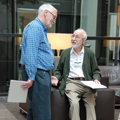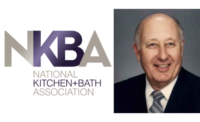Industry veteran was a world-renowned plumbing researcher.

My good friend, Dr. Lawrence Galowin, Ph.D., died on May 15. This sadly brings us to the end of an era. Larry was the last remaining researcher at the plumbing test labs at the National Bureau of Standards, now known as National Institute of Standards and Technology.
Larry joined the staff of NBS in 1974. He began at the end of the glory days in plumbing research. However, Larry was fortunate enough to do a lot of research, especially in air and wastewater movement.
I was fortunate enough to meet Larry in the spring of 1975. My senior year spring break trip was a working vacation that included a visit to the plumbing lab at NBS. A good friend who worked for the American Iron and Steel Institute arranged the trip. It was fascinating. What was really fascinating was the enthusiasm of the man in charge, Dr. Larry Galowin.
Larry and I became reacquainted three years later when I was considered for an internship as a researcher in the plumbing lab at NBS. Unfortunately, the internship was cancelled during the final phase of interviews.
But two years later, Larry and I started working together on the ASME A112 Committee. That is the committee that writes all the standards for plumbing fixtures. This was the start of a long friendship. Every time we would get together, we would talk about the latest in research. We also would talk about our favorite pastime, skiing. Larry skied well past the age of many skiers. That gives me hope to continue for many years to come.
Larry also introduced me to another great plumbing researcher, Professor John Swaffield, Ph.D. John, Larry and I had many dinners together. We also had dinners together with our wives. The wives would always marvel that we could talk all night about plumbing research.
When you look at the impact Larry had on our profession it is too much to mention in one column. Larry was a consummate leader in environmental, energy and health issues. While a federal employee at NBS, he worked with many other divisions of the federal government, giving advice and helping them properly regulate plumbing.
Lead and water conservation
In the early 1980s, Larry called me and said, “This lead is really, really bad!” That started the ball rolling on lead in drinking water issues. With Larry’s assistance, EPA held a symposium of all the plumbing experts. Those proceedings resulted in the first lead solder ban, finally leading to federal legislation. A few years later, NSF 61 was developed. All of this was based on one statement that “lead is really, really bad.” Yet, Larry will get little to no credit for starting the ball rolling.
When water conservation became a major concern, Larry was involved with Tom Konen at Stevens Institute of Technology in developing the new water-closet requirements, including test media and drain line carry requirements. He also promoted overall water conservation for the industry. He championed dual flush in this country. At the time, many people thought he was nuts. They said the American public would never buy into dual flush. Oops, I guess Larry was right.
One of the areas Larry is most known for is the air required for venting. His research dispelled so many myths in plumbing regarding venting. However, Larry was always bothered by the fact that the myths remain to this very day. We often hear those myths spouted at plumbing code hearings.
By quantifying the air movement and air necessary for venting, Larry actually helped with the introduction of air-admittance valves. While he didn’t have any interest with manufacturers, they used his research to justify a device for terminating a vent. Larry was a researcher who had no problem with the use of air-admittance valves in a plumbing system.
Larry also developed the reduced size venting formula and chart. This research shows that a 2-in. vent is not necessary for a water closet, nor is a 1 1/2-in. vent necessary. His research showed that for short runs of a vent a 1/2-in. vent is all that is needed. However, he preferred a 3/4-in. vent since it could run farther. Maybe one of these days the codes will add proper sizing tables, instead of over-sizing as Larry was famous for saying.
A rocket scientist and patriot
So many times we hear the expression plumbing isn’t rocket science. We used Larry as the person to counter this statement. We always considered Larry a rocket scientist involved in plumbing research. We needed a rocket scientist to figure everything out. Larry’s master’s degree is in aeronautical engineering. His Ph.D. is in applied mechanics. Prior to working at NBS, he did work in the aerospace industry, hence, a rocket scientist.
Larry was a true patriot. He was a part of the “greatest generation.” Growing up in Brooklyn, when Larry graduated from high school he joined the Army Air Force during World War II. He was a bombsite mechanic with the 487th Bomber Group stationed in England during the war. His group flew B-24 bombers over Europe. His war experience was always a part of him. He stayed involved with the 487th until he died. He received his education through the GI bill. Clearly, he was a success story for the program.
Larry’s wife, Mary Fowler, is the daughter of a Nobel laureate. I loved hearing stories about the two of them being in Sweden for the Nobel Prize awards.
Dr. Larry Galowin was 87 when he died of cardiomyopathy. Even at that age, he was still actively involved in helping the plumbing industry. He remained active on the A112 Committee, submitting comments on the standards and participating in conference calls.
After going into semiretirement, Larry was a visiting professor in 1998 and 1999 at Heriot-Watt University in Edinburgh, Scotland. He worked with Swaffield, who was head of the department. My wife and I joined the two and their wives at the International Conference, CIB W62, in Scotland in 1999. Larry always represented the United States at these conferences of international plumbing and sanitation researchers.
One thing I will never forget was receiving the call from Larry after 9/11. The patriot that he was, he immediately considered possible terrorist attacks on plumbing systems. He helped to assemble a group of experts to meet with federal officials to develop a response to any future attack. I felt very fortunate to be selected as a part of that group. To say the least, what we did will remain confidential. But I can say that we are in good hands.
What I will miss is Larry’s wit and wisdom. We have lost a link to the past in plumbing research at the NBS. But what Larry left behind will continue to change the face of plumbing engineering for years to come.

